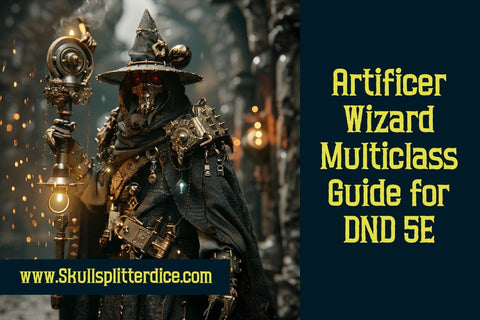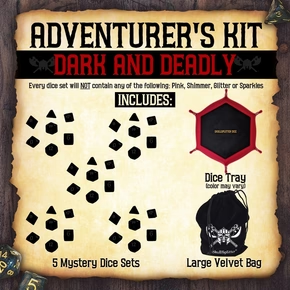
Artificer Wizard Multiclass Guide for Dungeons and Dragons 5e
Table of Contents:
Artificer Wizard Multiclass Guide for DND 5e
Sufficiently Advanced Technology
Artificers are mad inventors, pioneers of unexplored sciences who harness magic as if it were merely another natural force. Wizards are scholars of the arcane, masters of ancient secrets who twist reality to suit their whims. Put them together and we get a technomancer, a genius armed with both fabled magic and advanced technology that makes magic tangible and takes reality apart. Grab your wrench and your spellbook as we go through everything you need to know.

Why Play an Artificer/Wizard Multiclass?
Artificers and wizards are the only two classes in Dungeons & Dragons that use Intelligence as their primary spellcasting ability, making them the most likely multiclass for each other from the start. They work together as a full split or as a single level dip. They complement each other mechanically as well, since the artificer gains a ton of fun features but lacks raw spellcasting, while the wizard is almost entirely raw spellcasting with few features to play with. The combination is flexible, and can work as a support, healer, or a frontline fighter that can give other DPS classes a run for their money.
What are the Downsides?

Multiclass spellcasting is messy, and we’ll have to do some shenanigans to make it all work efficiently. Artificers are half-casters so every level we take in artificer gives us fewer spells than if we’d just been a full wizard. We can do some tricks to make up for it but when each base class is pretty squishy, the combination will be no different and will likely die easily just like a normal wizard.
Since artificers are half-casters any multiclassing will give us less powerful spellcasting than just normal wizard spell progression. And just like with any dual-class option, we’ll be getting mid-game features later and losing out on higher level features like capstones entirely. Multiclass characters in general tend to be weaker than characters of the same character level who only took a single class unless you take advantage of specific synergies and combinations.
What Class Features Do We Care About?
While not every feature and every character level is going to play a big role in our builds, you should be aware of the following class features while putting your artificer wizard together.
Significant Artificer Features
- Magical Tinkering. Gained at 1st level, you basically get to create a number of “tiny gadgets” equal to your Intelligence modifier. They can emit light, record and replay sounds, emit noises or odors, or relay messages. None of this is particularly impressive or useful to us, but having some bonus utility shenanigans under your belt is never a bad thing.
- Spellcasting. Artificer spellcasting works a bit like an Intelligence-based cleric with prepared spells and even some of the cleric cantrips. You get to prepare any artificer spells you’d like each day but are limited by your spell slots. The artificer spell list has a lot of overlaps with the wizard spell list using the same spellcasting ability, but with a few notable additions that will be worth picking out. Artificer spells also max out at 5th level spells, so we'll be relying on the wizard for the big stuff in the late game.
- Infuse Item. Starting at 2nd level the artificer gets to essentially “make” magic items that only last for a while. This, however, opens up all sorts of gadget possibilities from simple stuff like magic rapiers to on-demand magic ropes and gloves of thievery. Note that what gadgets you can make depends on your artificer level, so we’ll have to go hard into artificer if we want the really good options.
- Artificer Specialties. Artificers gain their archetypes at 3rd level and several of our builds rely on the 3rd level archetype features which vary wildly from chaos potions to magical suits of armor and heavy armor proficiency. We’ll go more into the artificer subclass options in a bit but just know for now they’ll factor into some of our builds.
Significant Wizard Features
- Spellcasting. Just like the artificer, with the wizard's spellcasting feature we're using intelligence as our spellcasting ability, but instead of preparing spells wizards need to learn their spells and add them to their spellbook. If you take this build down a regular spellcasting route the wizard spell list provides a huge variety of utility and damage spells that’ll carry you through. If we end up pushing for more of a martial build the wizard also gets the frankly broken sword cantrips booming blade and green-flame blade.
- Arcane Recovery. A somewhat underplayed ability unique to wizards, once per short rest you can regain some expended spell slots.
- Arcane Traditions. Wizards pick up their archetype at 2nd level with most options providing a unique ability alongside a “specialization” in a specific spell school. For typical spellcasting routes there are a ton of solid options to choose from, but for the melee combat there is really only one option and that’s bladesinger. Bladesinger lets us enter a “bladesong” using a bonus action, which lasts for 1 minute. While in this bladesong we get to add our Intelligence to our AC (which stacks with unarmored defense), we get yet another 10 feet of extra movement speed, advantage on acrobatics checks, and a bonus to concentration checks equal to our Intelligence modifier. You get a number of uses equal to your proficiency bonus.
What Level Does an Artificer Wizard “Kick In”?
We have some very different strategies to go for here but both rely on different archetype features from both classes. This means we need to at least pick up the artificer archetype at 3rd level, and the wizard archetype at 2nd level. That means for our builds we’ll typically be kicking in at our 5th character level.
Do I Take Artificer or Wizard First?

I would previously have said to absolutely take your first class level in wizard due to the spellbook equipment problem, but apparently through some tweets from Jeremy Crawford he confirmed that the spellbook is meant to be a “class feature” you’d gain through multiclassing. With that cleared up it’s a coin toss between them since you won’t be losing anything either way in regard to skill proficiency or tool proficiencies. The main difference will be the saving throw proficiencies. Both classes provide Intelligence saves but artificer provides Constitution saves while wizard provides Wisdom saves. I’d still recommend taking levels in wizard first though since a very low-level wizard is arguably stronger than a very low level artificer, but you won’t be “wrong” for taking artificer first.
Artificer / Wizard Ability Scores
One of the nice things about this multiclass combination is that both classes essentially use the same spread of ability scores.
Your highest ability score should be Intelligence as our spellcasting ability for both artificer and wizard spells.
Your next highest ability score should be Dexterity as we’ll be relying on light armor for our AC. Only go with medium armor if you have +2 Dex or less.
Finally, we need to survive as much punishment as possible while maintaining our concentration spells so our third highest ability score should be Constitution.
And that’s it really, we can dump Strength, Wisdom, and Charisma entirely making this a clean three ability multiclass combination.
Multiclass Spellcasting
When you make a multiclass spellcaster using two different spellcasting classes, things can get weird.
Firstly, a multiclass spellcaster technically needs two different types of spellcasting focus. “Tools of Artifice” for your artificer spells and an “arcane focus” for your wizard spells. Tools of artifice can be any set of craftsman tools, typically thieves’ tools or smith's tools. Unless we want spellcasting foci occupying both our hands we’ll need to get up to some shenanigans.
The first and easiest method for combining foci is simply to infuse our arcane focus with enhanced arcane focus. Once we hit our 2nd artificer level and gain infuse item, any item we infuse can also be used as our “tools of artifice”, so once we put an infusion on our arcane focus we suddenly have a single focus that works for all our spells.
The next option requires the armorer artificer archetype, as it allows you to use your suit of magic armor as the focus for your artificer spells. The armorer isn’t for all of our builds but if you do go this route the archetype just solves the problem for you.
Finally, we can take advantage of the feat war caster. War caster provides advantage on our Con saves to maintain spells, lets us cast spells for our opportunity attacks, and lets us perform somatic components of spells even when our hands are full of weapons. The wording is sort of funky, but the short answer is that with the feat, you just need the focus “on you” to cast the spells, but don’t need it in your hands.
The last option is to sort of ignore the whole issue by only casting your spells ahead of time and using the sword cantrips in combat (which obviously use the sword to cast instead of a focus). This is a bit constraining but if we’re locked in on that strategy anyway it’s not a bad choice.
Next, your spells known stay completely separate. Artificers are prepared casters and “know” all their spells of every spell level they have access to, but wizards have to either gain their spells by leveling up or by copying them into their spellbook. There’s a lot of overlap on the utility spells, so consider using your artificer slots for utility and using your wizard spells for damage.
The spell slots however combine into a special “multiclass spell slots table” which basically counts “half-caster” levels as half a level and “full-caster” levels as one level.
For our build, both artificers are “half-casters”, and wizards count as “full-casters” for determining caster levels. So, on the multiclass spellcaster table you’ll count half your artificer levels and your full total of wizard levels to determine your spell slot progression. For example, if we have 4 levels of artificer and 3 levels of wizard, we’ll count as having 5 caster levels on the table. This essentially means that every level of artificer slows our spell slot progression compared to normal wizard spell progression, so keep that in mind when figuring out your level split.
Multiclass Spellcaster Table
|
Level |
1st |
2nd |
3rd |
4th |
5th |
6th |
7th |
8th |
9th |
|
1st |
2 |
- |
- |
- |
- |
- |
- |
- |
- |
|
2nd |
3 |
- |
- |
- |
- |
- |
- |
- |
- |
|
3rd |
4 |
2 |
- |
- |
- |
- |
- |
- |
- |
|
4th |
4 |
3 |
- |
- |
- |
- |
- |
- |
- |
|
5th |
4 |
3 |
2 |
- |
- |
- |
- |
- |
- |
|
6th |
4 |
3 |
3 |
- |
- |
- |
- |
- |
- |
|
7th |
4 |
3 |
3 |
1 |
- |
- |
- |
- |
- |
|
8th |
4 |
3 |
3 |
2 |
- |
- |
- |
- |
- |
|
9th |
4 |
3 |
3 |
3 |
1 |
- |
- |
- |
- |
|
10th |
4 |
3 |
3 |
3 |
2 |
- |
- |
- |
- |
|
11th |
4 |
3 |
3 |
3 |
2 |
1 |
- |
- |
- |
|
12th |
4 |
3 |
3 |
3 |
2 |
1 |
- |
- |
- |
|
13th |
4 |
3 |
3 |
3 |
2 |
1 |
1 |
- |
- |
|
14th |
4 |
3 |
3 |
3 |
2 |
1 |
1 |
- |
- |
|
15th |
4 |
3 |
3 |
3 |
2 |
1 |
1 |
1 |
- |
|
16th |
4 |
3 |
3 |
3 |
2 |
1 |
1 |
1 |
- |
|
17th |
4 |
3 |
3 |
3 |
2 |
1 |
1 |
1 |
1 |
|
18th |
4 |
3 |
3 |
3 |
3 |
1 |
1 |
1 |
1 |
|
19th |
4 |
3 |
3 |
3 |
3 |
2 |
1 |
1 |
1 |
|
20th |
4 |
3 |
3 |
3 |
3 |
2 |
2 |
1 |
1 |
Artificer Wizard Equipment

Considering that the artificer class is essentially the “magic items class”, what to put on is a complicated question. We can augment a lot of our equipment choices by turning them into magical items, but for now we'll deal with the base items. There are three main strategies as far as your equipment is concerned, full spellcasting, armorer, or bladesinging.
For builds going for full spellcasting, we’re enhancing our arcane focus so that it can also be our tools of artifice, putting that in one hand and putting a shield in the other. Artificers have shield proficiency and I recommend taking advantage of that. Beyond that it’s just a matter of picking out the best armor depending on our Dexterity. With a +4 or lower in Dexterity, half-plate is the best option for us thanks to medium armor proficiency. If you manage to tick over into +5 Dexterity or higher then swap over to studded leather.
The armorer route is just like the full spellcasting route except we’re ditching the medium armor for heavy armor. Full plate is the goal, but it can be surprisingly hard to get a hold of depending on your Dungeon Master. Expect to make do with splint or chain mail for a while until you get enough gold to buy your full plate heavy armor.
If you’re going the bladesinging route, we likely take the war caster feat and slot a shortsword or scimitar into both of our hands while keeping our arcane focus in our kit but not equipped. Then in order to activate bladesinging we can’t have better than light armor, so we’re stuck with studded leather.
Artificer Wizard Spells
For the most part, the artificer spell list is a chunk of the wizard spell list with a few key additions. You're getting some extra cantrips between the artificer cantrips and the wizard cantrips but with just about the same access to spells. This means by combining them we basically have the same spellcasting power of a wizard in spells like magic missile and fireball, just with a little extra spice.
The first bit of that spice is the wonderful magic of healing with cure wounds, lesser restoration, and to a lesser extent aid, adding fundamental healing magic to our arcane arsenal. Cure wounds is unironically one of the best 1st level spells you can have and you can even push this build into a full healer and support caster, but they’re very useful to have on hand for any build. Note we don't have access to healing word, so you'll actually have to get in touch range if you decide to go full healer.
Heat metal is an incredibly rude damage over time spell that can ruin a heavily armored knight’s day, and it’s missing from the wizard spell list but included on the artificer list. It is situational, but in those situations where it works it’s one of the strongest damage spells around applying 2d8 fire damage every turn for the low cost of a bonus action and one of your 2nd level spell slots.
Next, and I feel like I go on about these spells in every other multiclass combination but the “sword cantrips” booming blade and green-flame blade are borderline busted. They cast “as a part” of a melee attack, and for martial caster combinations they typically represent free damage that you can stack up on your attacks. It's important to note that these do still count as "casting a spell" rather than taking an "attack action", mainly because you can't take advantage of extra attack unless you actually take an "attack action". You actually get access to these from both spell lists as either artificer cantrips or wizard cantrips, so you’ll be able to play with them even in your first couple levels.
Finally, the last spell that’s worth noting is revivify. Normally reserved for the divine casters, artificers can also pull somebody back from the dead for the low cost of 300 gp worth of diamonds. This will compete with fireball, the king of 3rd level wizard spells for your spell slots. Just keep some ice in your pockets and make sure you don't use up all your 3rd level spells on those 3rd level fireballs. Save one of those slots to cash in and save a teammate when things are dire.
Artificer Wizard Multiclass Builds
Combining these two classes is fairly forgiving and you should have a decent build regardless of how you go about it but consider the following strategies when planning your build.
Blursinger
This build is a variation on the classic bladesinging strategy which aims to turn our spellcaster into a martial powerhouse using sword cantrips. With this version of the build though, we can typically guarantee that our enemies will be attacking with disadvantage for the entire fight.
To accomplish this, we need just 3 levels of artificer selecting the armorer archetype and a two-level dip in wizard selecting the bladesinger archetype. We want to select the guardian armor model using studded leather. It’s a shame that bladesinging can’t use heavy armor but the buffs from bladesinging itself will make up for it. Next, we make sure to take either green-flame blade or booming blade as some of our cantrip options and blur as one of our 2nd level artificer spells. Finally, for one of our infusions make sure to pick mind sharpener, which gives us 4 “free passes” on concentration checks each day.
Bladesinger allows you to enter a “bladesong” as a bonus action. While in this blade song, we get to add our Intelligence to our AC, 10 feet of extra movement, advantage on acrobatics ability checks, and a bonus to concentration equal to our Intelligence modifier. We also get martial weapon proficiency in a single weapon of our choice. Unfortunately though, bladesong restricts us from using medium armor, heavy armor, or shields, so we won't be able to make the most of our armor proficiencies.
The guardian armor turns our hands into thunder gauntlets, that are melee weapons that deal 1d8 lightning damage, and impose disadvantage on our target’s attacks if they go for something other than us. We can also gain some temporary hit points equal to our artificer level, which isn’t a lot, but free hit points are free hit points.
So, let’s put this together. At the start of combat we take the first turn to cast the spell blur on ourselves and activate our bladesong. From the 2nd turn forward we can rush into battle, using both our action and bonus action to make two thunder gauntlet attacks for 15 lightning damage (2d8 + 6) or make a single thunder gauntlet attack as a part of casting green-flame blade for 21 average damage (2d8 + 3 +1d8 + 4) across two targets. Our thunder gauntlets also inflict a taunt effect, giving them disadvantage on attacks next turn unless they target you. The green flame is obviously extra damage, but using both gauntlets for additional attacks on multiple targets is useful if you want to apply the taunt to both enemies. We still always have the option of using our infusion to turn those gauntlets into even more powerful magic weapons, but that's not a necessity.
But we’re still essentially a base class squishy wizard you say? Well, we’re at 19 or 20 AC thanks to bladesong adding our Int to our AC on top of our Dexterity. Where it comes together though is through that blur spell which imposes disadvantage on attacks against you. Once you pop targets with the gauntlets, they’re now attacking at disadvantage no matter who they attack. Normally, blur’s big downside is that it’s a concentration spell, but since we’re not only adding our Int to concentration checks thanks to bladesong, we also have 4 free auto passes on our concentration checks thanks to the mind sharpener infusion.
This all means we can be slugging away with awesome lightning fists while every single attack from our targets that comes back at us or our party will be at disadvantage!
Indestructible Wizard
The goal here is to continuously generate so many temporary hit points every turn that you become indestructible, an infinite damage sponge that will laugh off every attempt to strike you down.
To accomplish this, we first need 3 levels of artificer taking the artillerist archetype and 2 levels of wizard picking the school of abjuration. We should also take variant human so that we can pick up the feat eldritch adept which lets us snag the warlock invocation armor of shadows. If your DM isn’t allowing variant human, you may have to go up one more level of artificer just for the 4th level ability score increase to spend on the feat. For equipment we can just take light armor (we plan on using mage armor anyway) along with a shield enhanced by the enhanced defense infusion.
The key features we’re going to abuse here are the artillerist’s protector eldritch cannon option, and the abjuration wizard’s 2nd level feature arcane ward.
The protector cannon is a special magic item that takes an action to set up initially and repeated as a bonus action, providing you and any of your allies within 10 feet with a number of temporary hit points equal to 1d8 + your Int modifier.
The arcane ward gives you a “magical ward” that soaks up a number of hit points equal to twice your wizard level + your Intelligence modifier. And whenever you cast an abjuration spell, the ward restores a number of hit points equal to twice the level of the spell cast. The real trick here is that while this arcane ward functions almost identically to temporary hit points, it isn’t technically temporary hit points which means it can stack with them and soak up extra damage.
Finally, we take advantage of armor of shadows, which lets us cast the spell mage armor for free without casting a spell slot. Mage armor is an abjuration spell, so it’ll trigger our arcane ward, not to mention it’s just a solid spell to have without wasting a slot. An alternative is to take the ritual casting feat so that you can ritual cast the cantrip alarm to top off your ward. You won't ward anything in particular but it still counts as an abjuration spell.
So, let’s put this all together assuming we have an 18 Int character. At the start of the day we cast mage armor on ourselves without spending a slot, giving us an arcane ward of 8 hit points. Once combat starts, we use our action to place down our protector, granting us and any of our allies within range another average 9 (1d8 + 4) temporary hit points. We have mage armor, a shield, and the enhanced defense infusion so our AC should be 19 (13 + 3 + 2 + 1). Every turn we can use our action to recast mage armor (or a damage spell if we aren’t hurt yet) and we can use our bonus action to get a temporary hit point or two back.
Even not counting the temporary hit points our allies gain, we now have an average buffer of 11 regained “hit points” per turn, without even expending any spell slots! You essentially have regeneration and can now face tank whole combats as the enemy pitifully attempts to chew through your endlessly regenerating wall.

Disclaimer
Last updated: January 27, 2019
The information contained on www.SkullSplitterDice.com website (the "Service") is for general information purposes only.
www.SkullSplitterDice.com is a participant in the Amazon Services LLC Associates Program, an affiliate advertising program designed to provide a means for sites to earn advertising fees by advertising and linking to Amazon.com. (source: Section 5)
Blueshift Nine, LLC assumes no responsibility for errors or omissions in the contents on the Service.
In no event shall Blueshift Nine, LLC be liable for any special, direct, indirect, consequential, or incidental damages or any damages whatsoever, whether in an action of contract, negligence or other tort, arising out of or in connection with the use of the Service or the contents of the Service. Blueshift Nine, LLC reserves the right to make additions, deletions, or modification to the contents on the Service at any time without prior notice.
Blueshift Nine, LLC does not warrant that the Service is free of viruses or other harmful components.
Affiliate disclaimer
This affiliate disclosure details the affiliate relationships of Blueshift Nine, LLC with other companies and products.
Some of the links are "affiliate links", a link with a special tracking code. This means if you click on an affiliate link and purchase the item, we will receive an affiliate commission.
The price of the item is the same whether it is an affiliate link or not. Regardless, we only recommend products or services we believe will add value to our readers.
By using the affiliate links, you are helping support the Service, and we genuinely appreciate your support.
Affiliate advertising programs that the Service uses are:
- Amazon Services LLC Associates Program
- As an Amazon Associate, I earn from qualifying purchases.
- Blueshift Nine, LLC is a participant in the Amazon Services LLC Associates Program, an affiliate advertising program designed to provide a means for sites to earn advertising fees by advertising and linking to Amazon.com or endless.com, MYHABIT.com, SmallParts.com, or AmazonWireless.com.
- Pages on this Service may include affiliate links to Amazon and its affiliate sites on which the owner of this Service, Blueshift Nine, LLC, will make a referral commission.